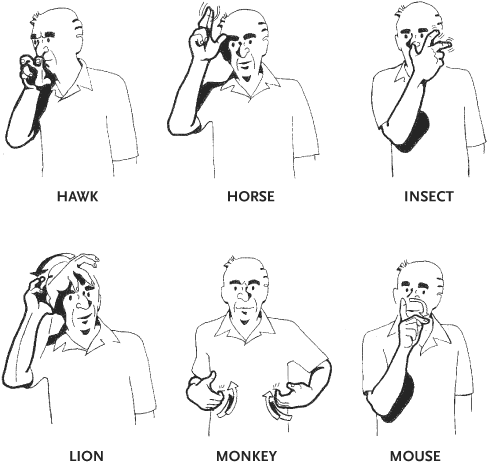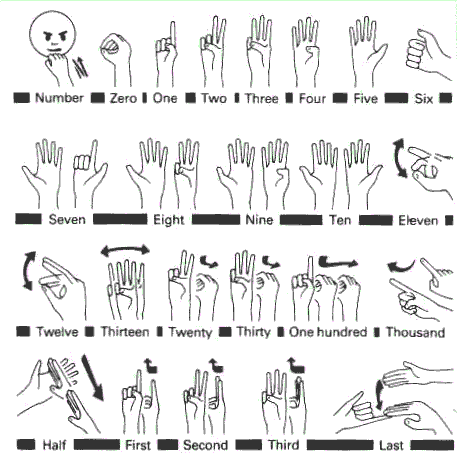It's nice to know sign language, just in case you ever need to use it in the future. Even if you don't, it'll make you feel smarter. If you're interested in expanding your brain, here are a few sign language infographics that'll teach you the basics:
1. How to Express Love
/filters:quality(70)/content/ms/ap/k8m1gj705655c24d53cdb470366156_600x776.jpg) If you want to tell your partner that you love them, then you should know how to do this sign. It's a combination of the letters "I," "L," and "Y."
If you want to tell your partner that you love them, then you should know how to do this sign. It's a combination of the letters "I," "L," and "Y."
2. What to Teach Your Baby
/filters:quality(70)/content/qi/k2/z4nzw2vq55e04b0b52a14825011758_600x2549.jpg) You can teach babies signs, so that they can communicate with you before they learn how to speak. After all, they're smarter than you think, so they'll catch on quickly.
You can teach babies signs, so that they can communicate with you before they learn how to speak. After all, they're smarter than you think, so they'll catch on quickly.
3. Day of the Deaf
/filters:quality(70)/content/xo/sx/nyeo11x75655c24db3288134184392_600x827.jpg) If you want to know how to say hello and goodbye, this is how you do it. As long as you can memorize which signs mean what, they're pretty easy to do.
If you want to know how to say hello and goodbye, this is how you do it. As long as you can memorize which signs mean what, they're pretty easy to do.
4. Feelings
/filters:quality(70)/content/jk/yr/eabh5pfz5655c25070b84283420814_300x420.jpg) If your facial expressions can't give away your feelings, then you can use signs.
If your facial expressions can't give away your feelings, then you can use signs.
5. Family Members
/filters:quality(70)/content/ta/yt/iclm38105655c24d84d65545675530_600x679.jpg) Here are the signs for all of your different family members. There are even signs for a few animals and drinks, as well!
Here are the signs for all of your different family members. There are even signs for a few animals and drinks, as well!
6. Routine
/filters:quality(70)/content/yn/er/ytczvfs25655c24d68314903799974_500x623.jpg) If you're about to brush your teeth or go to bed, you can use sign language to express your plans. This chart has a sign for every time of day.
If you're about to brush your teeth or go to bed, you can use sign language to express your plans. This chart has a sign for every time of day.
7. Letters
/filters:quality(70)/content/ve/d7/psjyq9p75655c24f07050212716821_600x438.jpg) If you're a beginner, you should really learn the alphabet. This chart will show you how to sign each and every letter.
If you're a beginner, you should really learn the alphabet. This chart will show you how to sign each and every letter.
8. Questions
/filters:quality(70)/content/ig/l9/lcqrp55q5655c250036b2885094679_600x770.jpg) If you have questions, this chart will show you how to ask them. It'll also show you how to say that you'd like to use the bathroom.
If you have questions, this chart will show you how to ask them. It'll also show you how to say that you'd like to use the bathroom.
9. Pledge Allegiance
/filters:quality(70)/content/wx/i3/b9aqxour5655c24fec759138643275_236x327.jpg) If you're still in school, you probably say the pledge of allegiance every single day. That's why you might as well learn how to say those words with your hands instead of your lips.
If you're still in school, you probably say the pledge of allegiance every single day. That's why you might as well learn how to say those words with your hands instead of your lips.
10. Survival Signs
/filters:quality(70)/content/nu/lk/jv9zj8475655c25170527338490150_277x358.jpg) Now you'll be able to tell others if you're hungry or thirsty. You'll also be able to say when you're feeling too hot or cold.
Now you'll be able to tell others if you're hungry or thirsty. You'll also be able to say when you're feeling too hot or cold.
11. Animals
 Are you an animal lover? Then you'll want to learn how to say the names of these adorable animals.
Are you an animal lover? Then you'll want to learn how to say the names of these adorable animals.
12. Colors
/filters:quality(70)/content/ay/x7/os3mqsmp5655c25322e71101405698_600x426.jpg) Now you can sign your favorite color!
Now you can sign your favorite color!
13. Numbers
 Numbers seem like a pretty easy thing to learn. Of course, once you get past ten, it can be a little tricky.
Numbers seem like a pretty easy thing to learn. Of course, once you get past ten, it can be a little tricky.
14. Ordering a Meal
/filters:quality(70)/content/hz/gi/p2942k8z5655c256326ce704452933_600x828.jpg) If you want to order food at a restaurant, now you'll know how to say what you're allergic to. You'll also be able to say how you'd like your meat cooked.
If you want to order food at a restaurant, now you'll know how to say what you're allergic to. You'll also be able to say how you'd like your meat cooked.
15. Winter Clothing
/filters:quality(70)/content/l8/iu/v7g4l47g5655c2563b6c0969858168_364x397.jpg) It's getting cold out. That's why it might be helpful to learn how to sign these clothing items.
It's getting cold out. That's why it might be helpful to learn how to sign these clothing items.
16. Random Words
 Here are a few words that might come in handy. After all, you're probably going to say "text" pretty often, don't you think?
Here are a few words that might come in handy. After all, you're probably going to say "text" pretty often, don't you think?
17. The Basics
/filters:quality(70)/content/ab/rq/cneqe1iu5655c2584812d499061753_310x304.jpg) You can't get through life without being able to say "please" and "thank you." Now you know how to be polite.
You can't get through life without being able to say "please" and "thank you." Now you know how to be polite.
Sign language will come in handy. That's why you should memorize as many of these signs as you can. Have you ever taken a class that was meant to teach you sign language?